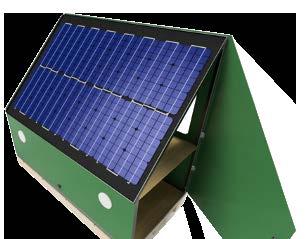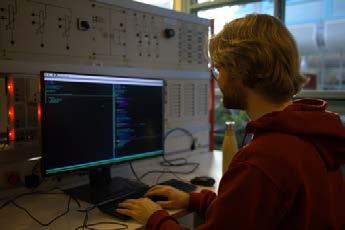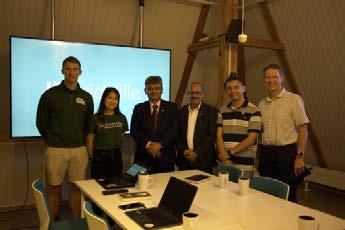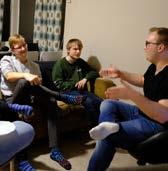






Gridville is a student project at NTNU Trondheim, created by Engineers Without Borders (EWB) NTNU, the local student department of EWB Norway. The project involves students designing and building a microgrid, which will supply a village that does not have access to electricity. The project combines sustainable electricity production with humanitarian aid work, which makes it a unique interdisciplinary project. Through this project, we want to give students the opportunity to immerse themselves in a central part of the energy network of the future, as well as gain practical experience with humanitarian aid-related issues.




The world is facing major challenges related to climate change. The energy demand is constantly increasing and the phasing out of non-renewable energy sources requires a new way of thinking about the production, transport and storage of electricity. These challenges hit developing countries in particular, as the transition to renewable energy and power grid development both require large investment costs.
At GridVille, we believe that a microgrid equipped with renewable energy sources can solve this problem. A microgrid does not require large investment costs, which can give people living far from existing power grids access to electricity.
Our long-term goal is to establish GridVille as an annual project, where a grid is designed and built for a new location every year. This is how we can do our part to change the fact that 789 million people do not have direct access to electricity. An annual project like GridVille does not exist in the world yet. We hope to lay the foundation and inspire other universities around the world to establish similar projects. Thus, we students together can electrify the world grid by grid.
This year the GridVille team consists of three main groups, the Electrical team, the Marketing and Finance team and our International Coordination team. The Electrical team consists of the following sub-groups, Controls Systems, Monitoring System, Converters and Sensors, and Power System. The Electrical team has eight members.The Marketing and Finance team is split into three sub-groups; Marketing, Finance and Design. There are six members in Marketing and Finance, two members in each sub-group. Our international lead coordinator Raihan is the only member of that team. Finally we have the board containing five members tasked with managing our technical organization. Their roles are Project Manager, Deputy Project Manager, Chief Electrical, Director of Marketing Sand Finance and the International Coordinator. The aforementioned compartmentalization has worked great and made our stride towards the end goal much more efficient.



This year our main focus has been the microgrid prototype and the brand book.
The marketing team has worked further on establishing the GridVille brand identity. A major development in this area has been the creation of our brand book. The brand book will function as a useful guide and rulebook for our future works, and how we should present ourselves.The marketing team also handles our social media platforms. They have aimed to post regularly on these. Once a week on Instagram, and twice a semester on Facebook and Linkedin. The frequency of which we post on said platforms represent their prominence on campus.
The types of content we post on these platforms also vary according to their intended audience. Linkedin is more corporate and posts here are targeted towards our sponsors and business partners. Instagram and Facebook are meant for our student audience and potential recruits. To end the year on a positive note, they are also planning to conduct a four week long Advent calendar give-away on Instagram. The winners shall be announced every Sunday of December leading up to Christmas. This serves as a useful marketing ploy for our organization’s social media platforms.
The design team has made great progress this semester.
They have designed a three dimensional rendering of our prototype. Which will be placed on campus next semester. They call the project “the box”, and it will contain a downscaled version of our final grid. The complete prototype will contain a solar panel, batteries, converters and a display containing statistics of our grid. This will be a great marketing tool and bring awareness to our project, as well as giving us valuable data.
Our finance team has reached out to various potential sponsors, and secured a sponsorship for the prototype’s solar panel.

For the autumn semester, the Electrical group has been getting into the rhythm of the development process and making minimum viable products of the different systems of our grid. In case you are not up to speed, our goal for this project is to make a prototype of our larger-scale grid. This will be a compact grid, packaged into a transportable box. It will feature a solar panel on the roof, and the accompanying components inside the box to protect them from the environment - batteries, inverters, converters, and control units. The primary load is phone- and laptop charging for bypassers, and potentially a waffle iron for sunny days when GridVillagers are hungry.
We are facing three main challenges with the prototype. To start with, we have decided on the topology of the grid, which required us to understand the interaction between each component, and the limitations of every part based on their data sheets. Now that this is done, it remains to dimension cables, circuit protections and then order said parts.
Our biggest challenge is making the control systems. Here, we are primarily focusing on the DC-part of the grid, while buying a pre-built inverter for the AC-part. To achieve this, we must imple-

ment MPPT-algorithms to maximize the solar panel's efficiency, and charging algorithms to both discharge and charge the batteries according to how much power the solar panel is generating and how much power the load is drawing. We are using a Texas Instruments microcontroller as our control unit. One of our core concepts, is that we are modelling our grid in Simulink, and integrating Texas Instruments' block set for programming their microcontrollers into this model. This allows us to test our code in the simulated system, and then compile it directly to the microcontroller to test it on the real grid. While we have not yet achieved all of this, we will soon test the MPPT-algorithm on hardware. Finally, we are making our own monitoring system with the goal of storing and visualizing important data from
the grid. This includes sensor data, f.ex. voltages, currents, state of charge for the batteries, and environmental data such as temperature and humidity. It can also store data about what the control system is doing and the state of the overall grid. We are running this system on a Raspberry Pi. While reading the mentioned data, it simultaneously uploads it to a time-series database (TimescaleDB) and displays the data in different diagrams on a monitor. To have such a tool is great, as it functions both as a safety measure, a debugging tool, and an eye-catcher for people taking a look at our prototype grid.
Progress is looking good, and the Electrical group is looking forward to the semester ahead, when we will integrate our systems with each other and complete the grid.
Camilla and I had a meeting with representatives from Kathmandu University, including the principal Bhola Thapa and several other academics who have supported GridVille in Kathmandu. The meeting was initiated by Ole Gunnar Dahlhag.
The discussion provided updates on GridVille’s progress at both NTNU and Kathmandu. We discussed the challenges and outlined future collaboration plans.
The primary objective of this meeting was to sketch out a preliminary plan for collaboration and the future student exchange between GridVille initiatives. Both parties were enthusiastic about student exchanges between NTNU and Kathmandu. Principal Thapa was very accommodating and supportive of NTNU students visiting Kathmandu. Bhola highlighted the 60-year energy collaboration between Norway and Nepal, noting that the two sister projects of GridVille symbolize this enduring partnership.
Following the meeting, GridVille, in collaboration with Ole Gunnar, decided to apply for funds to support the student exchange and further the microgrid project in Nepal.

Engineers Without Borders (E.W.B.) remains a collaborator and source of inspiration. Our year’s brandbook is inspired by theirs, and we have the same human resource department. To further our bond, we have established a “Scout arrangement” which serves as a security net for our members. Members seek the scout in their group

and give them a heads up about internal tribulations that cause problems for the group’s dynamic. We also collaborate on many social gatherings such as the annual cabin trip and Christmas party. Even though we collaborate, our plan to provide developing countries with renewable electricity is GridVille’s independent project.

The semester started with an admission period where we had many excellent applicants. From these we formed a team consisting of 19 members.
The first two weeks we had a bootcamp which included introduction meetings, workshops, and crash courses from old members of GridVille, namely Varshan Shankar and Maurice Sudkamp.
After bootcamp, Marketing and Finance started creating the brand identity for GridVille, showing activity on social media, contacting potential sponsors, and designing the prototype box.
The design sub-group went through different alternatives for the design, from the general shape to more details and building materials. After many hours of brainstorming and CAD work, they managed to come up with an excellent design for our prototype.
The group made goals to achieve to be presented at the design review and worked towards these goals.
The electrical group picked up where last year’s group finished. With a lot of research and reading they have managed to get a full understanding of our system and can build upon it. There
has been added a new subgroup in electrical, namely the monitoring system. This will input sensor data, which will be stored in a database as well as actively display the prototype measurements in real-time. In preparation for the design review, all the sub-groups had set optimistic goals to achieve before the design review. The feedback obtained at the design review would then be used to tune the system design before the exam period starts.

GridVille conducted the Design Review on November 12th, meeting with EWB NTNU, Revolve NTNU, and Propulse members. Presentations were successful, sparking productive discussions with various questions. Post-review, GridVille diligently revisited and adjusted our design considerations based on the valuable insights gained.


For the first phase, the goal is to design and implement a control system for a microgrid. This phase will provide GridVille with the required steps for designing and implementing a microgrid and will lay the foundation for upcoming phases. The goal is to obtain a stable system. The first phase is divided into two steps. The first consists of designing and implementing the microgrid, and the second consists of testing the system in a laboratory. Testing in the lab will be a crucial step for upcoming phases, and knowledge attained in this phase will therefore be valuable for the upcoming phases. Phase 1 is completed when GridVille has obtained a stable system. This can be verified through a system test in the laboratory. A successful system test will be obtained when exposed to all realistic operating scenarios without failures.
The second phase builds upon the first by constructing a microgrid that can withstand outdoor conditions. This will be done through the steps of the first phase with necessary adjustments for outdoor conditions. The system will be tested in the laboratory and, upon successful testing, tested outside. This phase aims to determine the necessary adjustments to make the system operate correctly outside. Phase 2 is completed when GridVille has a stable system that can withstand realistic operating scenarios without failure.
The final phase involves designing, implementing, and installing a microgrid for a specific location in a developing country. Knowledge from all previous phases will be necessary to achieve this goal. Phase 5 is completed when a working system with the requirements has been installed in the given location. These phases do not have predetermined timelines. They may take one year or more to complete. The duration is due to the importance of thoroughly completing each phase to gain a comprehensive understanding of the process, both technically and organizationally. After this, the goal is to design and produce a microgrid each or every second year.
The third phase involves using the knowledge gained in the previous phases to design, implement, and build a microgrid for a specific location in Norway. All steps from the previous phases will be followed, and the goal is to gain knowledge about designing a grid for a specific location, including protection, system variations, and reliability. phase 3 is completed when GridVille has installed and tested a working system on a given location.
The fourth phase aims to design a microgrid for a specific location in a developing country. Knowledge from all previous phases will be necessary, as well as an understanding of the country’s laws and regulations. This phase aims to learn about the required steps for implementing a microgrid in rural areas. Phase 4 is completed when GridVille has built a system that complies with the given requirements for this given location.

Full name:
Camilla Tran
Study:
Electrical Engineering Age: 24 Role:
Head of Marketing & Finance
What’s the next logical step for GridVille?
The next logical step for GridVille involves focusing on developing and finishing our prototype this year. Once that’s achieved, our plan is to establish a functional microgrid in Norway. This phased approach allows us to test our solutions in a controlled setting before expanding to other countries.
How would you describe your role and impact on GridVille?
In my three years as a member of GridVille, I’ve transitioned from being an active participant to taking on the role of leading this year’s Marketing and Finance team. In this role, my focus is on supporting the organization’s growth by overseeing marketing strategies and financial operations. Working closely with team members we’ve executed marketing strategies to expand our reach and enhance our brand presence. I appreciate the chance to play a role in furthering GridVille’s mission in this capacity.
I’m thankful for the opportunity to contribute to GridVille’s mission in this role. Whilemy contribution is just one element within the broader picture, I believe it adds value to the overall success of the organization.
What separates GridVille from the other technical organisations?
GridVille performs humanitarian work, which is no surprise since we are an off-spring from Engineers Without Borders NTNU. While a lot of other technical organisations participate in competitions, GridVille wants to offer solutions that can massively improve the quality of life for people in need of reliable electricity.
What’s the biggest reason you recommend GridVille to other students?
Having practical experience from extracurricular technical activities looks very good on your resumé. I guess the thing that scares a lot of people away from technical organisations, is the amount of work required by the members. Compared to the other organisations, GridVille is in the lower end on this scale. Also, the humanitarian aspect of our work makes everything feel more rewarding.

Age: 21

Full name: Pranav Cardenas Keshavan Study: MSc. in Water Science and Sustainability
Age: 26
Role: Finance Associate
What makes the GridVille work environment so good? Clear cut work division, very smooth, every one has an idea of what to do. Also there is a sense of community and mutual support between the members making it frictionless to work with.
What social events or activities has GridVille invited you to? Gridville has a good tradition of including everyone in any activities and social events. I myself have attended quite a few and it was an awesome experience in all.
THANK YOU TO OUR SPONSORS!





Sustainable power by students – creating value for others.